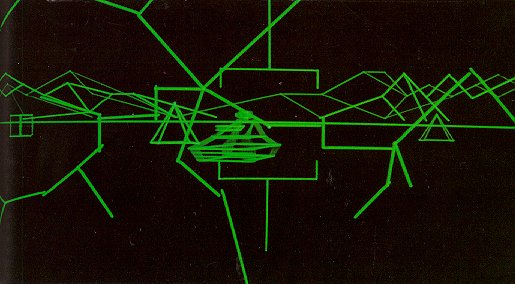
| worked for
a living," one of the pack admits. "For me," says
another, "a tough day is trying to find those two little bugs
in my game, so I spend hours playing it. Sometime, of course, you
have to spend hours pushing a pencil. And for most people here,
pushing a pencil is the most aggravating thing they could do."
Other labs are springing to life now, as more programmers and engineers say hello to their computers and ask what is on their simulated minds. Pushing open a door, I step into an unearthly greenhouse sprouting wires that climb the walls like clematis vines. An engineer who looks more like the gardener in faded jeans and boots is hunched almost into a video tube, his shirttails mentally flying as the computer bests him. Suddenly he pounds the control panel with his fists. "We stress-test all our games pretty thoroughly before they leave here," he announces wryly. Across the lab, a programmer in blue bib overalls is scratching a bird's nest of hair and swearing at his computer. On a shelf in front of him, a little vehicle has just gone haywire on the graphics display monitor. He types out a new instruction, pushes a control button, and watches intently. "It disappeared!" he sputters. "I know I didn't blow it up, so something else blew up! Like the program!" The gardener comes over to commiserate. "Is it breaking down?" he asks. "It hasn't become sane yet!" the programmer moans. "I have yet to convince it to speak anything that's even a semblance of reality!" One door down, things are working better. A wavy-haired woman in rosy velour and jeans spins a control ball with long slender fingers to move images around |
the screen.
Dona may go down in the annals of computer science as the programmer
who turned animations of centipedes and spiders into objects of
female fantasy. "I'm convinced my game is a woman's game,"she
says, with a soft Arkansas laugh. "It's a nice game. It's
very straightforward."
Like Dave, who yearned to work for Atari from the moment he saw the original Pong game in a bar, Dona was drawn to Atari by playing games in an arcade. She was working at General Motors' Delco plant in Santa Barbara, programming a microprocessor to govern such things as idle speed, spark advance and cruise control in the 1981 Cadillac. But GM's assembly-line approach to programming was frustrating ("Sometimes even two programmers is one too many") and the days were dull. "At GM, you could whisper if you had to, but don't talk and for God's sake, don't laugh," she says. So she escaped to a nearby arcade at lunchtime, out of boredom: "I knew about the Silicon Valley, everybody talked about it, but I read somewhere about Atari being up here and it just dawned on me: 'They make these games. What they do every day is what I do every day, but look what they get out of it. I get Cadillacs and they get these!' " What is it about these games? When Asteroids was still in the lab, on its way to becoming Atari's most popular game ever, Lyle was the force who helped make it work. "I was also," he admits, "the original Asteroids junkie. By junkie I mean I would go into the lab after work at five or six in the evening and start playing Asteroids, and when I would finally snap out |

